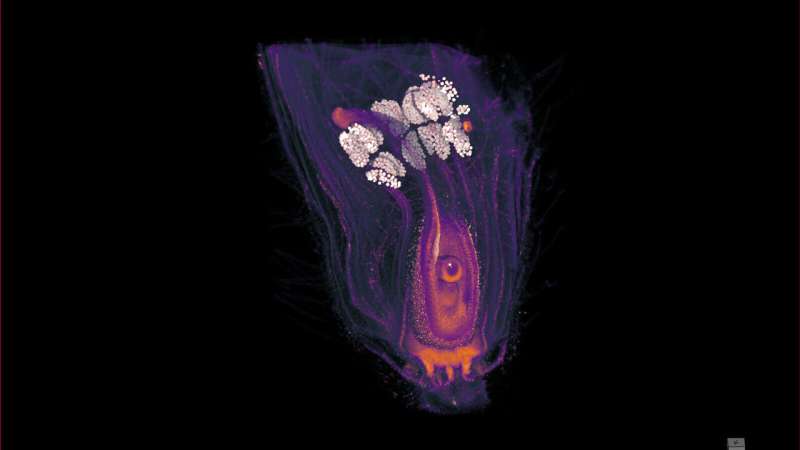Developing an unprecedented 3D X-ray microscope methodology to image plants at cellular resolution

Measuring plant phenotypes, a term used to describe the observable characteristics of an organism, is a critical aspect of studying and improving economically important crops. Phenotypes central to the breeding process include traits like kernel number in corn, seed size in wheat, or fruit color in grape. These features are visible to the naked human eye but are in fact driven by microscopic molecular and cellular processes in the plant. Using three-dimensional (3D) imaging is a recent innovation in the plant biology sector to capture phenotypes on the "whole-plant" scale: from miniscule cells and organelles in the roots, up to the leaves and flowers.
However, current 3D imaging processes are limited by time-consuming sample preparation and by imaging depth, usually reaching only a few layers of cells within a plant tissue. New research led by Christopher Topp, Ph.D., associate member at the Donald Danforth Plant Science Center, and Keith Duncan, a research scientist in his lab, have pioneered X-ray microscope technology to image plant cells, whole tissues, and even organs at unprecedented depths with cellular resolution. The work, supported by Valent BioSciences LLC and Sumitomo Chemical Corporation, was recently published in the scientific journal Plant Physiology. This work will enable plant scientists globally to study above and below-ground traits at revolutionary clarity.
"This paper focuses on the multiscale," says corresponding author Chris Topp, "because plants are multiscale. An ear of corn starts off as a microscopic group of cells called a meristem. Meristem cells will eventually form all the visible parts of the corn plant through division and growth." Their improved 3D X-ray microscopy (XRM) technology allows the researchers to relate the developmental microstructure of the plant, such as meristem cells, to visible traits as they mature, for example leaves and flowers. In other words, 3D XRM provides cellular-level resolution of entire plant organs and tissues.
In addition, their XRM methodology can also image below-ground structures at exceptional resolution, including roots, fungi, and other microbes. "Plant roots drive a lot of important biological processes; they feed microbes in the soil, and in return the plants get phosphorus and nitrogen," explains Topp. "We know the interaction between roots and microbes is important because it was a primary source of phosphorus and nitrogen before we invented chemical fertilizers." Our dependency on chemical fertilizers in standard agricultural practices have, in turn, made major contributions to global climate change. "Half of all the biologically-available nitrogen was made in a factory in the last 100 years," Topp continues. "This process has been estimated to use 3% of all available energy and generate 3% of greenhouse gas emissions on planet Earth every single year." Therefore, a critical component of the sustainable agriculture movement includes reducing chemical inputs and instead fostering natural interactions between roots and microbes below ground. "We haven't had the tools to understand these interactions until recently," says Topp. "3D XRM can help unlock the potential of re-establishing these natural alliances in our agriculture systems."
3D XRM methodology is unique compared to other imaging approaches in plant biology because of its ability to yield essentially perfect 3D clarity of plant structure. Other common methods, such as photon-based tomography, are limited by shallow imaging depths and are optimized in a select few species of plants. In contrast, by using 3D XRM, the team led by Topp and Duncan are able to image "thick tissues that are recalcitrant to typical, optical methods," in a whole host of economically important crops, including corn, foxtail millet, soybean, teff, and grape. "This paper is the first of its kind to show the breadth of what 3D XRM can do," Topp notes.
A major goal of the paper is to establish a reproducible protocol for other plant scientists interested in 3D XRM imaging. To do so, lead author Keith Duncan spent a lot of time—and trial and error—preparing samples to optimize the contrast between the plant and its background. X-ray imaging works through differential absorption, where dense material (like minerals in the soil) absorbs more X-rays and shows up darker on an image. However, biological matter like plant tissue has low X-ray absorption, and the team was at risk of completely washing out the material they were interested in imaging. "Solving that problem for one kind of sample—like a root tip—is one thing," explains Topp, "but the idea of the paper was to give plant scientists working on a variety of relevant plant tissues and species the access to these methods. We want to broadly apply 3D XRM to plant systems above and below ground." As such, their published methodologies greatly advance the number of plant species and the types of plant tissues that can be imaged at nearly perfect resolution.
Keith Duncan continues to lead the partnership of the Topp Lab with Valent Biosciences and Sumitomo Chemical, focusing on improving 3D XRM capabilities. He often collaborates with Kirk Czymmek, Ph.D., director of the Danforth Center's Advanced Bioimaging Laboratory, who was also an author on the paper.
Next on the horizon is to image 3D structures of fungal networks in the soil. Part of that work includes improving machine learning approaches, such that a computer is trained to recognize what within an image is a root, soil, or spore (the reproductive cells of a fungus). Their work will continue to develop new technological approaches to improve our multiscale understanding of the "whole plant," from the microscopic to the visible.
More information: Keith E Duncan et al, X-ray microscopy enables multiscale high-resolution 3D imaging of plant cells, tissues, and organs, Plant Physiology (2021). DOI: 10.1093/plphys/kiab405
Provided by Donald Danforth Plant Science Center





















